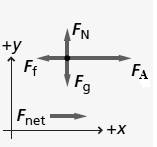
The time taken for the velocity of the box to become a given value.
Answer to Problem 24PP
The time taken for the velocity to double to 2 m/s is
Explanation of Solution
Given:
A force of 98-N is applied on a wooden box of mass 25-kg to move it along a wooden floor . The coefficient of kinetic friction between the two surfaces is 0.2.
Formula Used:
Here, a force is applied horizontally on the wooden box along the wooden floor . The entire distribution of forces on the box is shown in Figure 1.

Figure 1
There will be a force opposing the applied force which is due to kinetic friction. In this case, since the body is in motion, here, the body is in acceleration and hence there will be a net force in horizontal direction given by,
The net force is given by
Now, the kinetic friction force will be proportional to the normal force acting in the body. In this case, the normal force is equal to the weight of the body as there are no other forces along the normal.
Thus, the kinetic friction force can be expressed as,
Here,
Based on this, the magnitude of horizontal force to be applied can be deduced as,
And, the acceleration on the body can be calculated as,
Having found the acceleration, the time taken for the box to attain the given velocity from the initial value can be obtained as,
Calculation:
Given the mass of bookcase as 25-kg, and horizontal force as 98 N.
Now, by substituting the acceleration due to gravity and given parameters, the acceleration on the box in the horizontal direction can be calculated based on (5) as
Now, the time taken for the velocity of the box to attain 2 m/s from 1 m/s is obtained as,
Conclusion:
Thus, the time taken for the velocity to get doubled is 0.5 s.
Chapter 5 Solutions
Glencoe Physics: Principles and Problems, Student Edition
Additional Science Textbook Solutions
Campbell Biology (11th Edition)
College Physics: A Strategic Approach (3rd Edition)
Introductory Chemistry (6th Edition)
Campbell Essential Biology (7th Edition)
Human Anatomy & Physiology (2nd Edition)
Campbell Biology in Focus (2nd Edition)
- Hi! I need help with these calculations for part i and part k for a physics Diffraction Lab. We used a slit width 0.4 mm to measure our pattern.arrow_forwardExamine the data and % error values in Data Table 3 where the angular displacement of the simple pendulum decreased but the mass of the pendulum bob and the length of the pendulum remained constant. Describe whether or not your data shows that the period of the pendulum depends on the angular displacement of the pendulum bob, to within a reasonable percent error.arrow_forwardIn addition to the anyalysis of the graph, show mathematically that the slope of that line is 2π/√g . Using the slope of your line calculate the value of g and compare it to 9.8.arrow_forward
- An object is placed 24.1 cm to the left of a diverging lens (f = -6.51 cm). A concave mirror (f= 14.8 cm) is placed 30.2 cm to the right of the lens to form an image of the first image formed by the lens. Find the final image distance, measured relative to the mirror. (b) Is the final image real or virtual? (c) Is the final image upright or inverted with respect to the original object?arrow_forwardConcept Simulation 26.4 provides the option of exploring the ray diagram that applies to this problem. The distance between an object and its image formed by a diverging lens is 5.90 cm. The focal length of the lens is -2.60 cm. Find (a) the image distance and (b) the object distance.arrow_forwardPls help ASAParrow_forward
 College PhysicsPhysicsISBN:9781305952300Author:Raymond A. Serway, Chris VuillePublisher:Cengage Learning
College PhysicsPhysicsISBN:9781305952300Author:Raymond A. Serway, Chris VuillePublisher:Cengage Learning University Physics (14th Edition)PhysicsISBN:9780133969290Author:Hugh D. Young, Roger A. FreedmanPublisher:PEARSON
University Physics (14th Edition)PhysicsISBN:9780133969290Author:Hugh D. Young, Roger A. FreedmanPublisher:PEARSON Introduction To Quantum MechanicsPhysicsISBN:9781107189638Author:Griffiths, David J., Schroeter, Darrell F.Publisher:Cambridge University Press
Introduction To Quantum MechanicsPhysicsISBN:9781107189638Author:Griffiths, David J., Schroeter, Darrell F.Publisher:Cambridge University Press Physics for Scientists and EngineersPhysicsISBN:9781337553278Author:Raymond A. Serway, John W. JewettPublisher:Cengage Learning
Physics for Scientists and EngineersPhysicsISBN:9781337553278Author:Raymond A. Serway, John W. JewettPublisher:Cengage Learning Lecture- Tutorials for Introductory AstronomyPhysicsISBN:9780321820464Author:Edward E. Prather, Tim P. Slater, Jeff P. Adams, Gina BrissendenPublisher:Addison-Wesley
Lecture- Tutorials for Introductory AstronomyPhysicsISBN:9780321820464Author:Edward E. Prather, Tim P. Slater, Jeff P. Adams, Gina BrissendenPublisher:Addison-Wesley College Physics: A Strategic Approach (4th Editio...PhysicsISBN:9780134609034Author:Randall D. Knight (Professor Emeritus), Brian Jones, Stuart FieldPublisher:PEARSON
College Physics: A Strategic Approach (4th Editio...PhysicsISBN:9780134609034Author:Randall D. Knight (Professor Emeritus), Brian Jones, Stuart FieldPublisher:PEARSON





